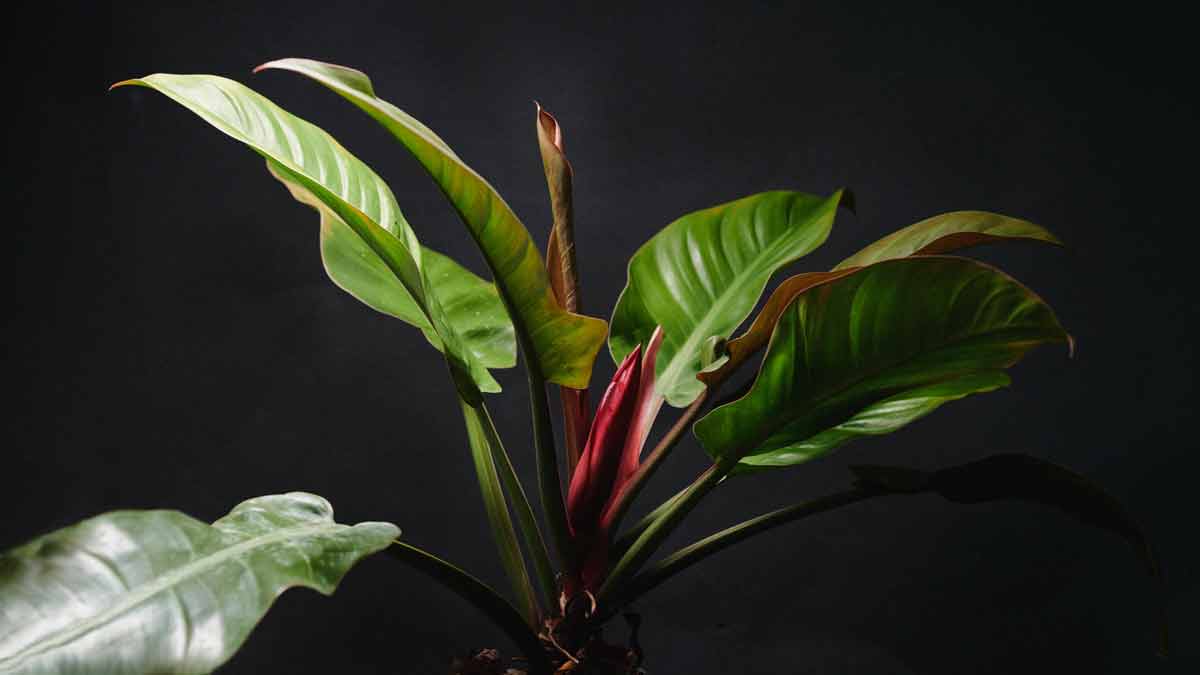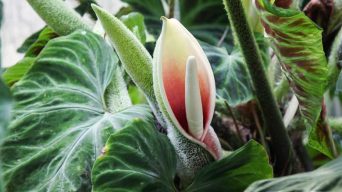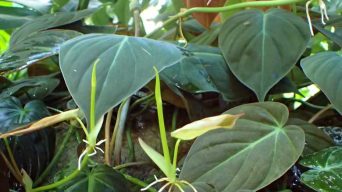Philodendron plants are one of the most popular houseplants and for a good reason!
They’re easy to care for, beautiful, and purify the air.
But even the best plants can sometimes get sick, and one of the most common problems philodendrons face is root rot.
This article will teach you everything you need to know about root rot in philodendrons, how to prevent it, and how to save your plant if it’s already affected.
What Is Root Rot?
Root rot is a disease that affects the roots of plants.
It is caused by fungi or bacteria that enter the plant through the roots and start to break down the tissue.
This can cause the roots to rot and the plant to become sick.
When the roots of a plant are affected by root rot, they can no longer take in water and nutrients from the soil.
This can cause several problems for the plant, including yellowing leaves, wilting, and death.
If you think your plant has root rot, it’s essential to act quickly. The sooner you start treatment, the better your chance of saving your plant.
What Causes Root Rot?
There are several reasons why your philodendron’s roots might start to rot.
The most common causes are:
Overwatering
This is by far the most common cause of root rot in philodendrons.
Philodendrons are native to tropical rainforests, where they grow beneath the canopy of taller trees.
They’re used to constantly moist air and soil and don’t tolerate drought well.
When you overwater your philodendron plant, the roots sit in waterlogged soil for too long.
This deprives them of oxygen, and they start to suffocate and rot.
Poor Drainage
If your philodendron’s pot doesn’t have good drainage, the roots can also rot from sitting in too much water.
Make sure you use a pot with drainage holes and put it on a drainage tray to catch any water that drains out.
Using the Wrong Potting Soil
Philodendrons prefer a light, airy potting mix that drains well.
If you use a heavy soil that doesn’t drain well, the plant roots can again start to rot.
This is especially a problem if you live in an area with high humidity, as the soil will stay wet for longer.
Compacted Soil
If the soil around your philodendron’s roots becomes too compacted, it can cause root rot.
This usually happens if you don’t repot your philodendron often enough, and the roots start to crowd the pot.
The compacted soil doesn’t allow the roots to breathe and start to rot.
Fungal Infection
Root rot is often caused by a fungal infection, such as Phytophthora or Pythium.
These fungi thrive in wet soil and attack the roots of plants, causing them to rot.
Fungi can be introduced to your plant in several ways, including:
- Using a contaminated potting mix
- Using contaminated water
- Contact with infected plants
Root Damage
If the roots of your philodendron are damaged, they’re more likely to rot.
Damaged roots can’t take up water and nutrients and start to die.
Damaged roots are also more susceptible to fungal infections, which can cause root rot.
What Does Philodendron Root Rot Look Like?
If your philodendron has root rot, you’ll notice a few symptoms.
These include:
Dropping Leaves
The first symptom of root rot is usually dropping leaves.
When Philodendron roots are healthy, they take water and nutrients from the soil and transport them to the leaves.
If the roots are damaged or rotting, they can’t do this, and the leaves start to drop.
Yellow Leaves
Another symptom of root rot is yellow leaves.
This is because the roots can’t take up nutrients from the soil, and the plant starts to starve.
The philodendron foliage exhibits a yellowing coloration and shows signs of declining vitality.
Wilting Leaves
If your philodendron’s leaves are wilting, it’s a sign that the roots can’t take up water from the soil.
The plant will start to wilt and look droopy.
Soft, Mushy Leaves
If you notice that your philodendron’s leaves are soft and mushy, it’s a sign of severe root rot.
The roots are so rotted that they can’t take up water or nutrients from the soil, and the leaves start to die.
Brown or Black Spots on the Leaves
If you see black or brown spots on philodendron leaves, it’s a sign of a fungal infection.
These fungi attack the leaves as well as the roots, and they cause the leaves to rot.
The spots will start small but eventually cover the whole leaf.
Mushy and Black Roots
If you notice that the roots of your philodendron are mushy and black, it’s a sure sign of root rot.
At this point, the roots are so rotted that they can’t support the plant, and it will start to die.
Healthy roots are white or light-colored and firm to the touch.
Bad Smell
Another symptom of root rot is a bad smell.
If you notice a foul odor coming from the pot, it’s a sign that the roots are rotting.
This is usually accompanied by other symptoms, such as yellowing leaves or mushy roots.
Soggy Soil
If you notice that the soil around your philodendron is always soggy, it’s a sign that the plant is overwatered.
The roots are sitting in water, and they’re starting to rot.
Drainage holes in the bottom of the pot will help to prevent this by allowing the water to drain out.
Stunted Growth
If your philodendron’s growth is stunted, it’s a sign that the roots are damaged.
Damaged roots can’t take up water and nutrients from the soil, so the plant doesn’t grow as well.
Although stunted growth is usually a symptom of root rot, it can also be caused by other problems, such as a lack of nutrients.
So, if you notice that your philodendron’s growth is stunted, check the roots to see if they’re damaged.
How To Treat Philodendron Root Rot
If you think your philodendron has root rot, it’s essential to act quickly.
Root rot is a severe problem; it can kill your plant if it’s not treated.
Here is a step-by-step guide to treating philodendron root rot:
1. Remove the Soil and Wash the Roots
The first step is to remove the plant from the pot and wash the roots.
This will get rid of any dirt or debris that might be causing the problem.
To do this, gently remove the plant from the pot and shake off any excess soil.
Then, rinse the roots under cool water.
2. Prune the Roots
Once you’ve removed the soil, you need to prune the roots.
This will get rid of any dead or rotted roots.
Using a sharp knife or pair of scissors, cut away any brown or black roots.
You should also cut away any mushy or soft roots.
3. Discard the Soil
Once you’ve pruned the roots, you must discard the old soil.
This will get rid of any fungi or bacteria that might be causing the problem.
Use a new potting soil mix when you replant the philodendron.
4. Wash the Pot
After you’ve removed the plant and the soil, you need to wash the pot.
This will get rid of any dirt or debris that might be causing the problem.
Clean the pot with a mild soap and water solution.
5. Repot the Plant in Fresh Soil
Once you’ve cleaned the pot, you can repot the plant in fresh soil.
Use a new potting soil mix, and add drainage holes to the bottom of the pot.
6. Water the Plant Carefully
Water the plant carefully, and make sure not to overwater it.
Allow the top inch of soil to dry before watering the plant again.
7. Give the Plant Plenty of Light
Give the plant plenty of bright indirect light, but don’t place it in direct sunlight.
An east- or west-facing window is a good spot for your philodendron.
8. Monitor the Plant Closely
Monitor the plant closely, and watch for any new symptoms.
If you notice that the plant is still not doing well, you may need to consult a professional.
Preventing Philodendron Root Rot
The best way to deal with root rot is to prevent it in the first place.
Here are some tips for preventing philodendron root rot:
Use Well-draining Soil
Philodendrons like their roots to be moist, not soaked.
Be sure to plant your philodendron in a pot with well-draining soil.
The best way to ensure good drainage is to mix equal parts perlite, peat moss, and coarse sand.
You can also add a layer of gravel to the bottom of your pot.
Don’t Overwater
It’s important not to overwater your philodendron.
Allow the top inch or two of soil to dry before watering again.
In the winter, you can water even less.
The best way to tell if your plant needs water is to stick your finger in the soil.
If it feels dry, it’s time to water.
If it feels moist, wait a few days and check again.
Use Pots with Drainage Holes
Pots without drainage holes can trap water and lead to root rot.
Be sure to use a pot with drainage holes to allow excess water to escape.
Place Your Philodendron in an Indirect Light
Philodendrons like bright indirect sunlight.
You can place your plant near a sunny window but protect it from direct sunlight, which can scorch the leaves.
If you’re unsure if your plant is getting enough light, the leaves will give you a clue.
If they start to turn yellow, that’s a sign that it’s not getting enough light.
Provide Air Circulation
Good air circulation is essential for preventing philodendron root rot.
Be sure to place your plant in an area with good airflow.
You can also help increase airflow by placing a fan near your plant.
Just be sure not to point the fan directly at the plant, as this can cause the leaves to dry.
Remove Dead or Dying Leaves
Dead or dying leaves can provide a place for mold and mildew to grow.
Be sure to remove any dead or dying leaves from your plant as soon as possible.
You can also help prevent problems by regularly cleaning the leaves with a soft cloth.
Repot in New Soil Every One to Two Years
Over time, the soil in your pot can break down and become compacted.
This can lead to poor drainage and an increased risk of root rot.
With time the soil also loses its nutrients.
To prevent these problems, it’s a good idea to repot your philodendron in new soil every one to two years.
Use Fertilizer Sparingly
You can fertilize your philodendron, but be sure to do it sparingly.
Too much fertilizer can burn the roots and lead to root rot.
A good rule of thumb is to fertilize once a month during the growing season, using half the recommended amount on the fertilizer label.
In the winter, you can fertilize even less, or not at all.
Check for Pests
Pests can provide a place for mold and mildew to grow.
Be sure to check your plant regularly for pests and remove them as soon as possible.
Some common philodendron pests include aphids, mealybugs, scale, and spider mites.
Monitor Your Plant
Be sure to watch your philodendron for any signs of root rot.
Some common symptoms include yellowing leaves, wilting, and stunted growth.
If you see any of these symptoms, taking action immediately is essential.
The sooner you catch the problem, the easier it will be to fix.
Final Thoughts
Preventing root rot in philodendrons is much easier than trying to save a plant that’s already affected.
To avoid problems, ensure your plant is never sitting in water, especially not for extended periods.
If you live in an area with high humidity, ensure the soil around your philodendron is well-draining.
And finally, don’t forget to check the roots periodically to ensure they’re healthy and white.
If you think your philodendron has root rot, there’s still hope.
With proper care and treatment, it’s possible to save your plant.
But be warned, it’s a long and challenging process.
If you’re not up for the challenge, starting over with a new plant might be best.







